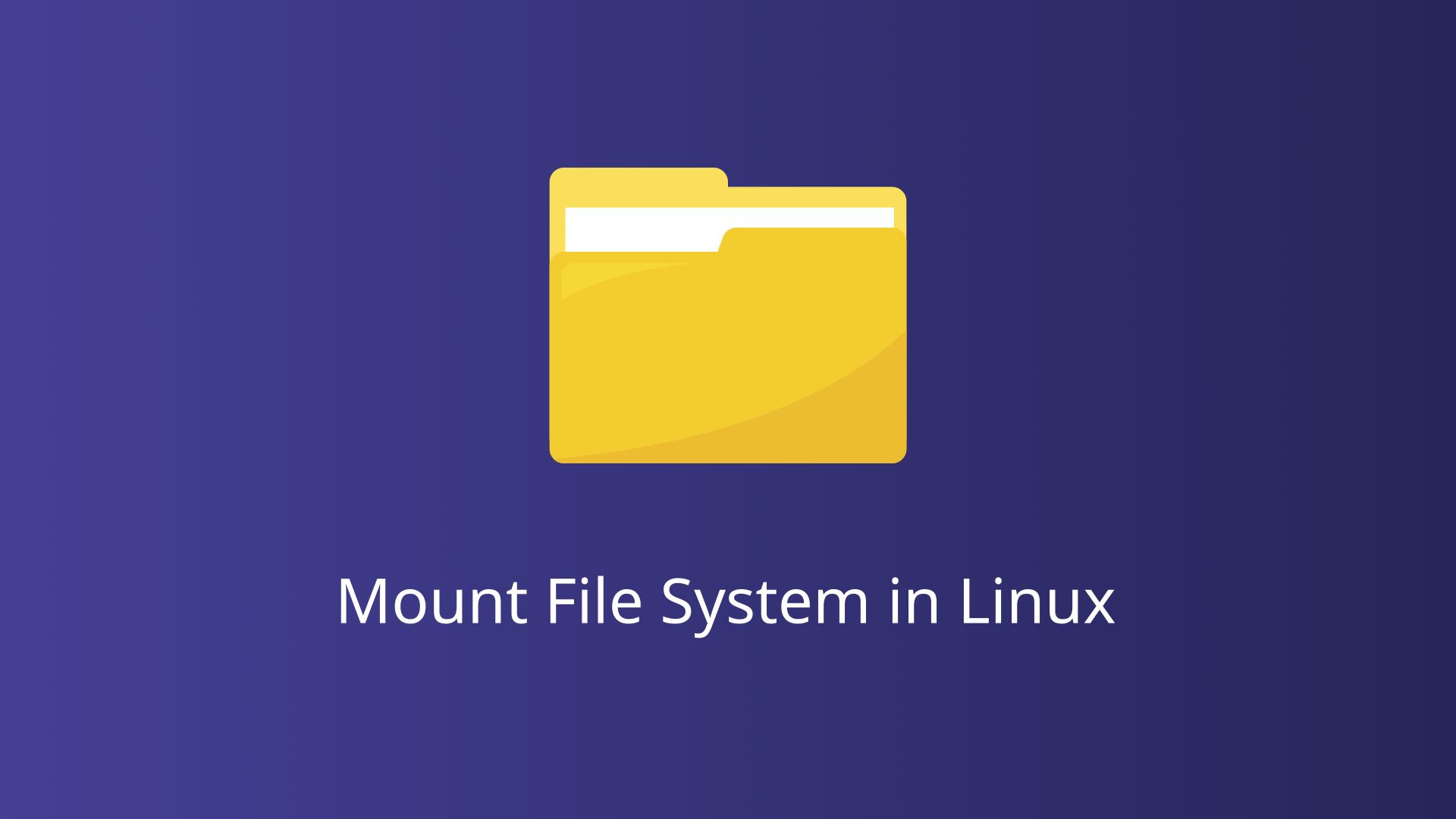Mounting is the process of making a file system accessible at a certain point in the Linux directory tree. The mount command attaches the file system found on some device to the big file tree. Conversely, unmounting detaches the file system, ensuring that no data is lost during this process.
In Linux, everything is treated as a file, and the root directory (/) is the starting point of the directory tree. When you mount a file system, you’re essentially integrating it into this tree, allowing seamless access to its contents.
The mount Command
The mount command is used to attach file systems to the directory tree. The basic syntax for mounting a file system is:
mount [options] <device> <mount_point><device>: The storage device or partition you want to mount (e.g.,/dev/sda1).<mount_point>: The directory where you want to mount the file system (e.g.,/mnt/data).
Common Options for mount
t: Specifies the file system type (e.g.,ext4,ntfs).o: Provides additional options, such as read-only (ro), read-write (rw), and others.
Mounting Different Types of File Systems
Linux supports various file system types, including but not limited to ext4, NTFS, FAT32, and NFS.
Ext4
Ext4 is the default file system for many Linux distributions, known for its reliability and performance. Here are some common mounting options:
Basic Mounting: Standard mount command for ext4 file systems.
sudo mount -t ext4 /dev/sda1 /mnt/dataRead-Only: Mount the file system in read-only mode.
sudo mount -t ext4 -o ro /dev/sda1 /mnt/dataNTFS
NTFS is commonly used in Windows environments. Linux supports NTFS through the ntfs-3g driver, allowing read and write operations.
Basic Mounting: Standard mount command for NTFS file systems.
sudo mount -t ntfs-3g /dev/sda1 /mnt/ntfsRead-Only: Mount the NTFS file system in read-only mode.
sudo mount -t ntfs-3g -o ro /dev/sda1 /mnt/ntfsFAT32
FAT32 is widely used for USB drives and memory cards due to its compatibility with multiple operating systems.
Basic Mounting: Standard mount command for FAT32 file systems.
sudo mount -t vfat /dev/sda1 /mnt/fat32With UTF-8 Encoding: Ensure file names are encoded in UTF-8.
sudo mount -t vfat -o utf8 /dev/sda1 /mnt/fat32With umask Option: Set file permissions using umask.
sudo mount -t vfat -o umask=000 /dev/sda1 /mnt/fat32exFAT
exFAT is optimized for flash drives and is supported on most modern operating systems.
Basic Mounting: Standard mount command for exFAT file systems.
sudo mount -t exfat /dev/sda1 /mnt/exfatWith umask Option: Set file permissions using umask.
sudo mount -t exfat -o umask=000 /dev/sda1 /mnt/exfatXFS
XFS is a high-performance file system suitable for large-scale data storage and high-throughput environments.
Basic Mounting: Standard mount command for XFS file systems.
sudo mount -t xfs /dev/sda1 /mnt/xfsWith Noatime Option: Disable access time updates to improve performance.
sudo mount -t xfs -o noatime /dev/sda1 /mnt/xfsWith Quota Options: Enable user and group quotas.
sudo mount -t xfs -o usrquota,grpquota /dev/sda1 /mnt/xfsBtrfs
Btrfs is a modern file system with advanced features like snapshots and built-in RAID support.
Basic Mounting: Standard mount command for Btrfs file systems.
sudo mount -t btrfs /dev/sda1 /mnt/btrfsWith Compress Option: Enable file system compression.
sudo mount -t btrfs -o compress=zlib /dev/sda1 /mnt/btrfsWith Subvolume Option: Mount a specific subvolume.
sudo mount -t btrfs -o subvol=@ /dev/sda1 /mnt/btrfsNFS
NFS allows you to mount remote file systems over a network, commonly used in enterprise environments.
Basic Mounting: Standard mount command for NFS shares.
sudo mount -t nfs server:/path/to/share /mnt/nfsWith Read-Only Option: Mount the NFS share in read-only mode.
sudo mount -t nfs -o ro server:/path/to/share /mnt/nfsWith Specific Port: Specify a port for the NFS service.
sudo mount -t nfs -o port=2049 server:/path/to/share /mnt/nfsUnmounting File Systems
Unmounting a file system detaches it from the directory tree, making its contents inaccessible until it is mounted again. The umount command is used for this purpose. The basic syntax is:
umount <mount_point>or
umount <device>Automating Mounting on Boot
To automatically mount file systems at boot, you need to add entries to the /etc/fstab file. The fstab file contains information about file systems and mount points.
Understanding fstab Entries
Each line in /etc/fstab follows this format:
DEVICE MOUNT_POINT FILESYSTEM_TYPE OPTIONS DUMP PASS| Field | Description |
|---|---|
| DEVICE | The device file (e.g., /dev/sda1) or UUID. |
| MOUNT_POINT | The directory where the file system will be mounted. |
| FILESYSTEM_TYPE | The type of file system (e.g., ext4, ntfs). |
| OPTIONS | Mount options (e.g., defaults, noatime). |
| DUMP | Backup operation indicator (usually set to 0). |
| PASS | File system check order (0 to disable). |
ext4 File System
Open the /etc/fstab file using a text editor:
sudo nano /etc/fstabAdd the line at the end of the file.
/dev/sda1 /mnt/data ext4 defaults 0 2Replace /dev/sda1 with your desired device and /mnt/data with your desired mount point. Repeat the steps for other file system given below.
NTFS File System
/dev/sdb1 /mnt/windows ntfs-3g defaults 0 0FAT32 File System
/dev/sdc1 /mnt/usb vfat defaults 0 0NFS File System
192.168.1.100:/exported_directory /mnt/nfs nfs defaults 0 0Using UUIDs in fstab
Using UUIDs (Universally Unique Identifiers) instead of device files is more reliable, as device names can change. To find the UUID of a device, use the blkid command:
sudo blkid /dev/sda1Look for the entry associated with your NTFS partition. It will resemble something like this:
/dev/sda3: UUID="XXXXXXXX-XXXX-XXXX-XXXX-XXXXXXXXXXXX" TYPE="ntfs" PARTUUID="XXXXXXXX-XX"Copy the UUID value.
Open the /etc/fstab file using a text editor:
sudo nano /etc/fstabAdd a line at the end of the file using the UUID. Replace YOUR_UUID with the actual UUID you obtained in the previous step.
UUID=YOUR_UUID /mnt/your_mount_point ntfs-3g defaults,auto 0 0Replace /mnt/your_mount_point with the desired mount point.
Applying fstab Changes
After editing /etc/fstab, you can test the configuration without rebooting:
sudo mount -aThis command mounts all file systems listed in /etc/fstab.
Troubleshooting
Encountering errors during the process of mounting file systems is a common occurrence in Linux environments. One frequently encountered error message is “failed to mount: wrong fs type, bad option, bad superblock.” Should you encounter this error, there are effective solutions available to resolve it.
For detailed steps and solutions to address this issue, I recommend consulting the blog post titled How to Fix “Failed to Mount: Wrong FS Type, Bad Option, Bad Superblock” on Linux. This resource offers comprehensive guidance on diagnosing and rectifying common mounting errors, enabling you to efficiently troubleshoot any challenges you may encounter while mounting file systems on Linux.
Conclusion
Mounting file systems in Linux is a fundamental skill for managing storage devices and ensuring data accessibility. By understanding the mount and umount commands, as well as how to configure automatic mounting with /etc/fstab, you can efficiently manage various file systems in your Linux environment. Whether you’re working with internal drives, external USB devices, or network shares, mastering these concepts will significantly enhance your ability to handle data storage and retrieval tasks.




